Monthly Newsletter – January 2020: Top 12 Takeaways from Matthew Gardner for 2020, A Macro-to-Micro Look at the Economy & Housing Market

 Last week, I had the pleasure of attending our office’s 11th Annual Matthew Gardner Economic Forecast Event. At this event, Matthew gives the crowd a review of the previous year and forecasts trends for the economy and housing market for the next year and beyond. Below are my Top 12 Takeaways worth noting as you start to chart your economic goals for 2020 and beyond.
Last week, I had the pleasure of attending our office’s 11th Annual Matthew Gardner Economic Forecast Event. At this event, Matthew gives the crowd a review of the previous year and forecasts trends for the economy and housing market for the next year and beyond. Below are my Top 12 Takeaways worth noting as you start to chart your economic goals for 2020 and beyond.
- He anticipates our next recession taking place in 2021, not 2020 as previously thought. The last 11 recessions averaged 58 months in between one recession to the next, and we are currently at 127 months since the last recession, so we are due. Worth noting is the next recession will not be based on housing like the previous recession. It is predicted to be a more normal adjustment that should also be short in length, unlike the Great Recession of 2008-2010.
- Recessions do not always cause home prices to drop. Of the last six recessions, home prices actually ended up higher than when the recession began with the exception of the Great Recession of 2008-2010, which was based on housing due to predatory lending.
- The U.S. Economy will add 1.8M new jobs, but national unemployment rates should rise to 4% from 3.5% by the end of 2020. However, wage growth should start to improve as that has been slow over the last decade. In the Greater Seattle area, unemployment hovered at 3% in Q3 of 2019.
- We are living in our homes longer. In 2019, the average home seller in the U.S had owned their home for an average of 8.2 years compared to the average home seller in 2000 at 4.2 years. This is reflective of homeowners choosing to build more equity over time before they cash-out and move on to the next home, as well as the increased amount of Baby Boomers coming to market with their long-time homes as they pivot towards retirement.
- We are not headed toward a housing bubble. When seasonally adjusted, home prices are still 5.8% below the prior peak. In addition, predatory lending practices were eliminated after the 2008 housing crash and the average down payment is much higher. Overall, home equity is high with the national average in Q3 2019 sitting at 26.7% and the average FICO score of a borrower in Q3 of 2019 was 755. This, along with foreclosure starts being low, indicates that we are not headed towards a housing bubble.
- Interest rates should remain under 4% in 2020. These are historical lows, but reflective of the last decade. In 2010, rates were around 5% and were as low as 3.4% in 2012. In late 2018, rates almost crested 5% but careened down under 4% for most of the year. The 2000’s averaged 6.3%, the 1990’s 8.1%, the 1980’s 12.7%, and the 1970’s 8.9%. This should put today’s rates in perspective.
- Single-family new construction remains muted due to the expensive cost of land, labor, materials, and regulatory fees. This has made inventory levels tighter and the appreciation of existing homes stronger. The lack of overbuilding is also another contributing factor to no housing bubble.
- Millennials are a force in the real estate market! They are the largest generation at 79M, are the largest cohort in the U.S. workforce, and more than 1M Millennial women are becoming moms every year. This generation has grown up and is experiencing big life transitions that lead to home ownership decisions. Nationally, they accounted for 37.5% of home purchases in Q3 of 2019. In the Greater Seattle area in 2019, 46% of home purchases were done by Millennials with an average down payment of 17% and with a FICO score of 741.
- The Greater Seattle economy looks to outperform the U.S. economy due to continued corporate growth, specifically in information services, which will balance out any losses we may see due to the current setbacks in aerospace.
- In the Greater Seattle area, as we start 2020 inventory levels are tight due to a high level of absorption over the course of 2019 after a big inventory dump in mid-2018. Many investors offloaded properties in 2018 and it took time to absorb this inventory as it accompanied a time frame where interest rates were near 5%. The market softened at that time, but now we have returned to constricted inventory levels and lower interest rates. This will bode well for home sellers and provide buyers low debt service.
- The average sale price in King County in December of 2019 was $830,000 and King County saw a 3% increase in home prices in all of 2019 over all of 2018. It is predicted, due to low inventory, strong job growth. and low interest rates that year-over-year price appreciation in King County in 2020 will be around 6.6%. Affordability and consumer sentiment are the biggest challenges in King County, especially in-city Seattle and on the Eastside, which are closer to job centers.
- The average sale price in Snohomish County in December of 2019 was $552,000 and Snohomish County saw a 5% increase in home prices in 2019 over 2018. It is predicted, due to low inventory, strong job growth, and low interest rates that year-over-year price appreciation in Snohomish County in 2020 will be around 7.3%. Snohomish County has benefited from the high prices in King County, leading folks to purchase further out for affordability purposes.
If you would like more information or a copy of Matthew’s PowerPoint, please reach out. It is my goal to help keep my clients well-informed in order to empower strong decisions. 2020 looks to be another positive year in real estate! If you or anyone you know is considering either buying or selling, please use me as a resource. It is an honor to help people make such important investments and meaningful lifestyle choices.
As Chief Economist for Windermere Real Estate, Matthew Gardner is responsible for analyzing and interpreting economic data and its impact on the real estate market on both a local and national level. Matthew has over 30 years of professional experience both in the U.S. and U.K.
In addition to his day-to-day responsibilities, Matthew sits on the Washington State Governors Council of Economic Advisors; chairs the Board of Trustees at the Washington Center for Real Estate Research at the University of Washington; and is an Advisory Board Member at the Runstad Center for Real Estate Studies at the University of Washington where he also lectures in real estate economics.
 I am pleased to present the fourth-quarter 2019 edition of the Gardner Report, which provides insights into select counties of the Western Washington housing market. This analysis is provided by Windermere Real Estate Chief Economist Matthew Gardner. I hope that this information will assist you with making better-informed real estate decisions. For further information about the housing market in your area, please don’t hesitate to contact me.
I am pleased to present the fourth-quarter 2019 edition of the Gardner Report, which provides insights into select counties of the Western Washington housing market. This analysis is provided by Windermere Real Estate Chief Economist Matthew Gardner. I hope that this information will assist you with making better-informed real estate decisions. For further information about the housing market in your area, please don’t hesitate to contact me.
 In 2019 Windermere agents, offices, and staff raised nearly $3 million for the Windermere Foundation, surpassing $40 million total raised since 1989. These dollars stay local, supporting low-income and homeless families in the communities where we do business. We’re proud of the work we’ve done so far, but there’s so much left to do. As we begin 2020, we look forward to seeing how we can further impact each community we serve.
In 2019 Windermere agents, offices, and staff raised nearly $3 million for the Windermere Foundation, surpassing $40 million total raised since 1989. These dollars stay local, supporting low-income and homeless families in the communities where we do business. We’re proud of the work we’ve done so far, but there’s so much left to do. As we begin 2020, we look forward to seeing how we can further impact each community we serve.
Windermere and the Seahawks are Back for Another Season to #TackleHomelessness!

All of us at Windermere are very excited to kick off our third season as the Official Real Estate Company of the Seattle Seahawks!
Once again, our #tacklehomelessness campaign is front-and-center, with the Windermere Foundation donating $100 for every Seahawks home-game tackle during the 2018 season to YouthCare, a Seattle-based non-profit organization that has been providing services and support to homeless youth for more than 40 years. Over the last two years, the Seahawks helped us raise over $66,000 through our #tacklehomelessness campaign, and this year we are looking forward to raising even more money – and awareness – for this important cause.
Our partnership with the Seahawks and YouthCare fits perfectly with the mission of the Windermere Foundation which is to support low-income and homeless families in the communities where we have offices. Through the #tacklehomelessness campaign, we hope to be able to do even more.
Back to School Basics

The first day of school sneaks up so fast… summer is here and then gone in a flash! Use these helpful tips to start getting settled into a new routine for fall, before life gets hectic.
Start talking about it. New teacher, new classmates, new schedules can all create some anxieties with kids. Start talking about school a few weeks before the first day. Talk about practical things like what the new schedule will be like, but also make sure to address their feelings and concerns about the upcoming year.
Go back to school shopping early. The store aisles are currently packed with school supplies. Take advantage of your summer schedule to shop while the store isn’t as busy and the supplies haven’t been picked through. Don’t forget to buy extras for homework time or the winter re-stock that inevitably happens in January.
Determine how your child will get to and from school and practice the route.
Ease back into the scheduled days. When you and your kids are used to lazy mornings and staying up late, shifting to the early morning school bus rush can be incredibly difficult. To ease the transition, start 7-10 days before school starts, and shift bedtimes and wake-up times gradually. Every day, start their bedtime routine 10-15 minutes earlier and wake them up 10-15 minutes earlier until they’re back on track. And don’t forget to readjust your bedtime schedules, too!
Re-set eating habits. When school starts, your student’s eating patterns need to maintain a high level of energy throughout the day. Implementing a routine for breakfast, lunch and snacks is just as important as their sleeping patterns. Begin this transition 7-10 days before school starts as well.
Sync your calendars. Add the school calendar to your personal/family calendar, so important dates like parent-teacher night aren’t missed.
Set rules for after school. After-school time and activities such as TV, video games, play time, and the completion of homework should be well-thought out in advance. Talk about the rules (and consequences) for these before school starts.
Monthly Newsletter

August 8th-10th will be an exciting time in Seattle. Pearl Jam, Seattle’s own original grunge band will be hosting two shows at Safeco Field on August 8th and 10th, and the Seattle Seahawks kick off their preseason schedule at Century Link on August 9th. Besides providing great entertainment for music and football fans, both of these events will give back to the community.
The two Pearl Jam shows have been coined The Home Shows as Seattle is Pearl Jam’s home town; but more importantly, proceeds from both shows will be donated to organizations such as Mary’s Place, the YMCA and The Mockingbird Society to help fight homelessness. These organizations have programs in place that are helping to improve the homeless crisis in our city. The Windermere Foundation has partnered with Pearl Jam and their Vitalogy Foundation and joined other organizations such as Alaska Airlines, Nordstrom, Tom Douglas, and The Bill and Melinda Gates Foundation to help sponsor these two benefit shows.
The Windermere Foundation has always been rooted in working towards overcoming homelessness and helping families and children get back on their feet. The Home Shows aligned with the Windermere Foundation’s mission, making it a natural fit for this partnership. Check out this video of Mike McCready, Pearl Jam’s guitarist serenading Windermere for our partnership.
On August 9th, the Seattle Seahawks kick off their pre-season schedule which also kicks off the Windermere Foundation’s third year of partnering with the Seattle Seahawks to Tackle Homelessness. For every defensive tackle that takes place at a regular season home game, the Windermere Foundation will donate $100 towards Youth Care, an organization that helps youth struggling with homelessness or transitional living.
Thanks to the generosity of Windermere agents, staff, franchise owners, and the community, the Windermere Foundation has proudly donated a total of $920,351 so far this year to non-profit organizations that provide services to low-income and homeless families. This brings the total amount of money that the Windermere Foundation has raised since 1989 to over $36 million.
Each Windermere office has its own Windermere Foundation fund account that they use to make donations to organizations in their local communities. Our office recently sent 24 low-income children to YMCA’s Camp Orkila and Camp Colman with funds that we raised. These kids will enjoy a life changing week of summer camp, meeting new friends and experiencing the outdoors. These experiences would not be possible without the support of our clients. For each transaction that Windermere closes, the Windermere agent involved makes a donation to the Windermere Foundation. Thank you for your support of my business, it helps make the Windermere Foundation possible!
The first day of school sneaks up so fast… summer is here and then gone in a flash! Use these helpful tips to start getting settled into a new routine for fall, before life gets hectic.
Start talking about it. New teacher, new classmates, new schedules can all create some anxieties with kids. Start talking about school a few weeks before the first day. Talk about practical things like what the new schedule will be like, but also make sure to address their feelings and concerns about the upcoming year.
Go back to school shopping early. The store aisles are currently packed with school supplies. Take advantage of your summer schedule to shop while the store isn’t as busy and the supplies haven’t been picked through. Don’t forget to buy extras for homework time or the winter re-stock that inevitably happens in January.
Determine how your child will get to and from school and practice the route.
Ease back into the scheduled days. When you and your kids are used to lazy mornings and staying up late, shifting to the early morning school bus rush can be incredibly difficult. To ease the transition, start 7-10 days before school starts, and shift bedtimes and wake-up times gradually. Every day, start their bedtime routine 10-15 minutes earlier and wake them up 10-15 minutes earlier until they’re back on track. And don’t forget to readjust your bedtime schedules, too!
Re-set eating habits. When school starts, your student’s eating patterns need to maintain a high level of energy throughout the day. Implementing a routine for breakfast, lunch and snacks is just as important as their sleeping patterns. Begin this transition 7-10 days before school starts as well.
Sync your calendars. Add the school calendar to your personal/family calendar, so important dates like parent-teacher night aren’t missed.
Set rules for after school. After-school time and activities such as TV, video games, play time, and the completion of homework should be well-thought out in advance. Talk about the rules (and consequences) for these before school starts.
South Snohomish County Quarterly Market Trends
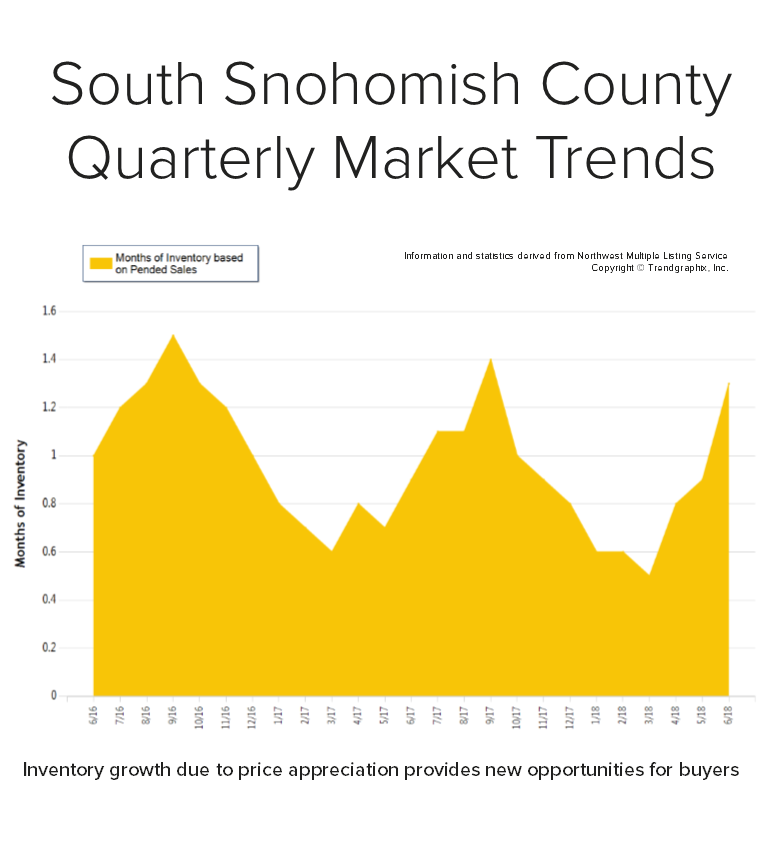
 As we head into the summer months we are seeing a healthy jump in inventory in our area. In May, we saw the biggest jump in new listings in a decade! Price appreciation has created this phenomenon, motivating many people to make big moves with their equity. In fact, prices are up 13% year-over-year. We currently sit at 1.3 months of inventory based on pending sales. This more-equal balance of homes for sale compared to the first quarter has created great opportunities for buyers, finally! While it is still a seller’s market, it has eased up a bit. The average days on market in June was 11 days and the average list-to-sale price ratio was 102%.
As we head into the summer months we are seeing a healthy jump in inventory in our area. In May, we saw the biggest jump in new listings in a decade! Price appreciation has created this phenomenon, motivating many people to make big moves with their equity. In fact, prices are up 13% year-over-year. We currently sit at 1.3 months of inventory based on pending sales. This more-equal balance of homes for sale compared to the first quarter has created great opportunities for buyers, finally! While it is still a seller’s market, it has eased up a bit. The average days on market in June was 11 days and the average list-to-sale price ratio was 102%.
South Snohomish County real estate has been an affordable option compared to “in-city” real estate. In fact, the median price in June was 41% higher in Seattle Metro. Sellers are enjoying great returns due to buyers choosing to lay down roots in our area, and buyers are securing mortgages with minor debt service due to low interest rates. The easing of inventory is a welcome change and is helping to temper price growth.
This is only a snapshot of the trends in south Snohomish County; please contact me if you would like further explanation of how the latest trends relate to you.
North Snohomish County Quarterly Market Trends
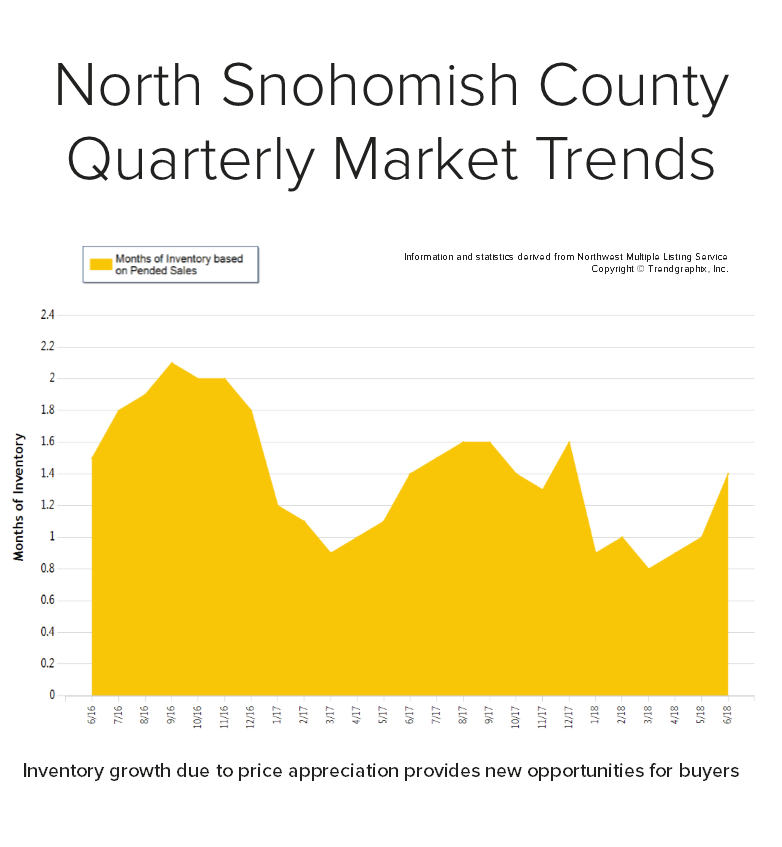
 As we head into the summer months we are seeing a healthy jump in inventory in our area. In May, we saw the biggest jump in new listings in a decade! Price appreciation has created this phenomenon, motivating many people to make big moves with their equity. In fact, prices are up 11% year-over-year. We currently sit at 1.4 months of inventory based on pending sales. This more-equal balance of homes for sale compared to the first quarter has created great opportunities for buyers, finally! While it is still a seller’s market, it has eased up a bit. The average days on market in June was 21 days and the average list-to-sale price ratio was 101%.
As we head into the summer months we are seeing a healthy jump in inventory in our area. In May, we saw the biggest jump in new listings in a decade! Price appreciation has created this phenomenon, motivating many people to make big moves with their equity. In fact, prices are up 11% year-over-year. We currently sit at 1.4 months of inventory based on pending sales. This more-equal balance of homes for sale compared to the first quarter has created great opportunities for buyers, finally! While it is still a seller’s market, it has eased up a bit. The average days on market in June was 21 days and the average list-to-sale price ratio was 101%.
North Snohomish County real estate has been an affordable option compared to “in-city” real estate. In fact, the median price in June was 86% higher in Seattle Metro. Sellers are enjoying great returns due to buyers choosing to lay down roots in our area, and buyers are securing mortgages with minor debt service due to low interest rates. The easing of inventory is a welcome change and is helping to temper price growth.
This is only a snapshot of the trends in north Snohomish County; please contact me if you would like further explanation of how the latest trends relate to you.
North King County Quarterly Market Trends
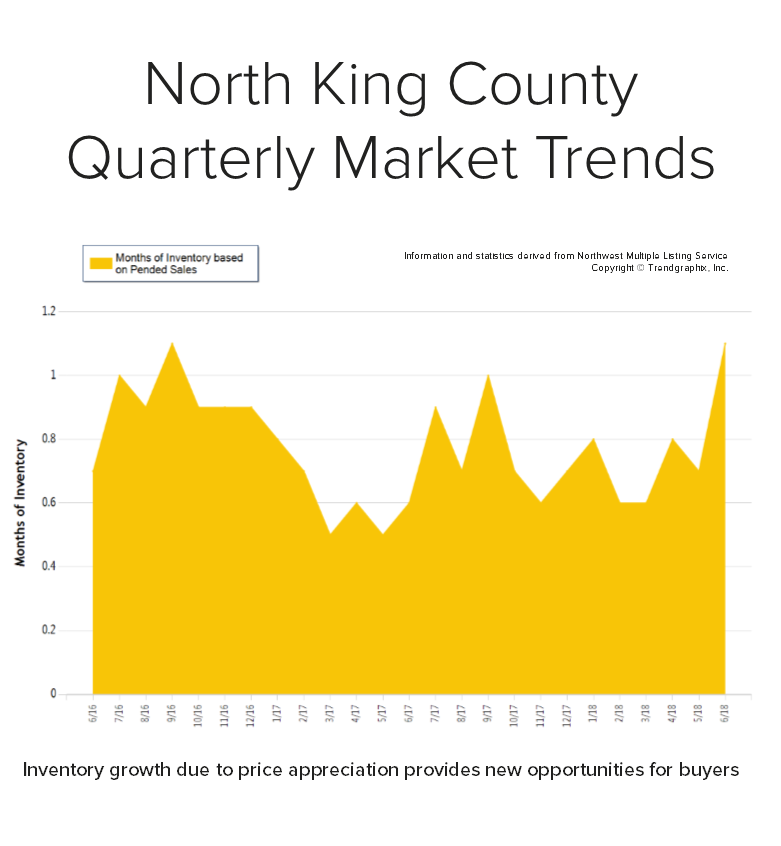
 As we head into the summer months we are seeing a healthy jump in inventory in our area. In May, we saw the biggest jump in new listings in a decade! Price appreciation has created this phenomenon, motivating many people to make big moves with their equity. In fact, prices are up 13% year-over-year. We currently sit at 1.1 months of inventory based on pending sales. This more-equal balance of homes for sale compared to the first quarter has created great opportunities for buyers, finally! While it is still a seller’s market, it has eased up a bit. The average days on market in June was 16 days and the average list-to-sale price ratio was 103%.
As we head into the summer months we are seeing a healthy jump in inventory in our area. In May, we saw the biggest jump in new listings in a decade! Price appreciation has created this phenomenon, motivating many people to make big moves with their equity. In fact, prices are up 13% year-over-year. We currently sit at 1.1 months of inventory based on pending sales. This more-equal balance of homes for sale compared to the first quarter has created great opportunities for buyers, finally! While it is still a seller’s market, it has eased up a bit. The average days on market in June was 16 days and the average list-to-sale price ratio was 103%.
North King County real estate has a very high premium due to close-in commute times and vibrant neighborhoods. In fact, the median price in June was $800,000. Sellers are enjoying great returns due to buyers choosing to lay down roots in our area, and buyers are securing mortgages with minor debt service due to low interest rates. The easing of inventory is a welcome change and is helping to temper price growth.
This is only a snapshot of the trends in north King County; please contact me if you would like further explanation of how the latest trends relate to you.
Seattle Metro Quarterly Market Trends

 As we head into the summer months we are seeing a healthy jump in inventory in our area. In May, we saw the biggest jump in new listings in a decade! Price appreciation has created this phenomenon, motivating many people to make big moves with their equity. In fact, prices are up 15% year-over-year. We currently sit at 1.1 months of inventory based on pending sales. This more-equal balance of homes for sale compared to the first quarter has created great opportunities for buyers, finally! While it is still a seller’s market, it has eased up a bit. The average days on market in June was 15 days and the average list-to-sale price ratio was 102%.
As we head into the summer months we are seeing a healthy jump in inventory in our area. In May, we saw the biggest jump in new listings in a decade! Price appreciation has created this phenomenon, motivating many people to make big moves with their equity. In fact, prices are up 15% year-over-year. We currently sit at 1.1 months of inventory based on pending sales. This more-equal balance of homes for sale compared to the first quarter has created great opportunities for buyers, finally! While it is still a seller’s market, it has eased up a bit. The average days on market in June was 15 days and the average list-to-sale price ratio was 102%.
Seattle Metro real estate has a very high premium due to close-in commute times and vibrant neighborhoods. In fact, the median price in June was $800,000. Sellers are enjoying great returns due to buyers choosing to lay down roots in our area, and buyers are securing mortgages with minor debt service due to low interest rates. The easing of inventory is a welcome change and is helping to temper price growth.
This is only a snapshot of the trends in the Seattle Metro area; please contact me if you would like further explanation of how the latest trends relate to you.
Eastside Quarterly Market Trends
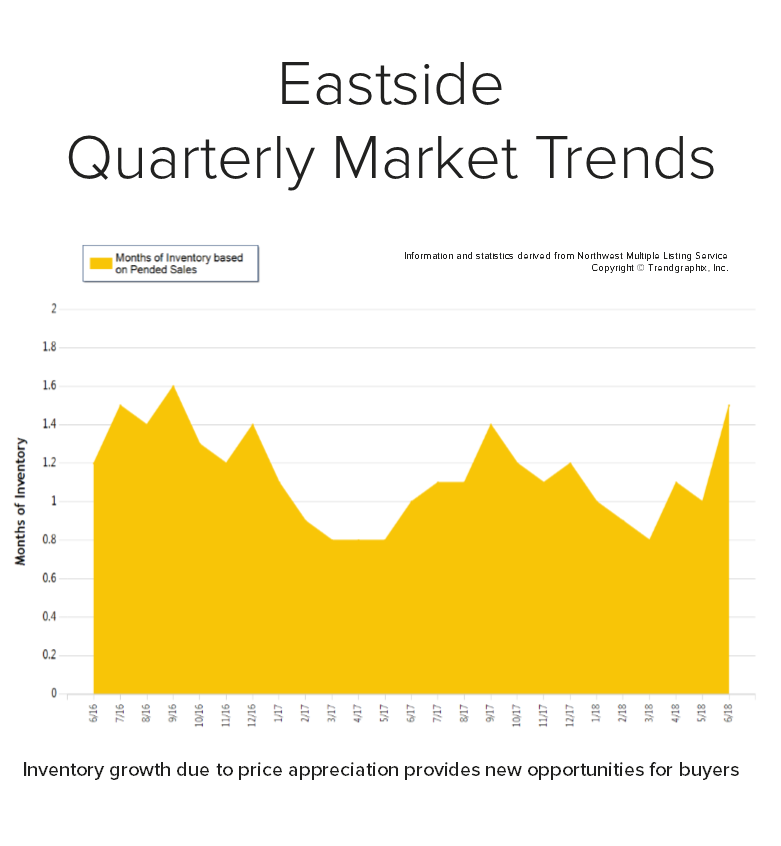
 As we head into the summer months we are seeing a healthy jump in inventory in our area. In May, we saw the biggest jump in new listings in a decade! Price appreciation has created this phenomenon, motivating many people to make big moves with their equity. In fact, prices are up 11% year-over-year. We currently sit at 1.5 months of inventory based on pending sales. This more-equal balance of homes for sale compared to the first quarter has created great opportunities for buyers, finally! While it is still a seller’s market, it has eased up a bit. The average days on market in June was 19 days and the average list-to-sale price ratio was 101%.
As we head into the summer months we are seeing a healthy jump in inventory in our area. In May, we saw the biggest jump in new listings in a decade! Price appreciation has created this phenomenon, motivating many people to make big moves with their equity. In fact, prices are up 11% year-over-year. We currently sit at 1.5 months of inventory based on pending sales. This more-equal balance of homes for sale compared to the first quarter has created great opportunities for buyers, finally! While it is still a seller’s market, it has eased up a bit. The average days on market in June was 19 days and the average list-to-sale price ratio was 101%.
Eastside real estate has a very high premium due to close-in commute times, great neighborhoods and strong school districts. In fact, the median price in June was $980,000. Sellers are enjoying great returns due to buyers choosing to lay down roots in our area, and buyers are securing mortgages with minor debt service due to low interest rates. The easing of inventory is a welcome change and is helping to temper price growth.
This is only a snapshot of the trends on the Eastside; please contact me if you would like further explanation of how the latest trends relate to you.
South King County Market Trends
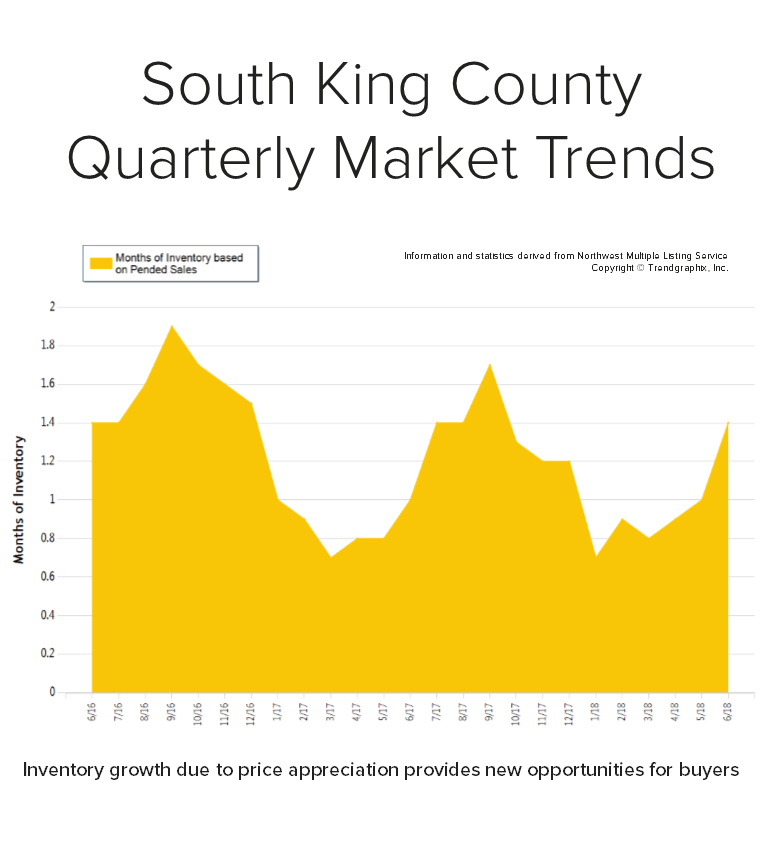
 As we head into the summer months we are seeing a healthy jump in inventory in our area. In May, we saw the biggest jump in new listings in a decade! Price appreciation has created this phenomenon, motivating many people to make big moves with their equity. In fact, prices are up 13% year-over-year. We currently sit at 1.4 months of inventory based on pending sales. This more-equal balance of homes for sale compared to the first quarter has created great opportunities for buyers, finally! While it is still a seller’s market, it has eased up a bit. The average days on market in June was 15 days and the average list-to-sale price ratio was 101%.
As we head into the summer months we are seeing a healthy jump in inventory in our area. In May, we saw the biggest jump in new listings in a decade! Price appreciation has created this phenomenon, motivating many people to make big moves with their equity. In fact, prices are up 13% year-over-year. We currently sit at 1.4 months of inventory based on pending sales. This more-equal balance of homes for sale compared to the first quarter has created great opportunities for buyers, finally! While it is still a seller’s market, it has eased up a bit. The average days on market in June was 15 days and the average list-to-sale price ratio was 101%.
South King County real estate has been an affordable option compared to “in-city” real estate. In fact, the median price in June was 75% higher in Seattle Metro. Sellers are enjoying great returns due to buyers choosing to lay down roots in our area, and buyers are securing mortgages with minor debt service due to low interest rates. The easing of inventory is a welcome change and is helping to temper price growth.
This is only a snapshot of the trends in south King County; please contact me if you would like further explanation of how the latest trends relate to you.
 Facebook
Facebook
 X
X
 Pinterest
Pinterest
 Copy Link
Copy Link




